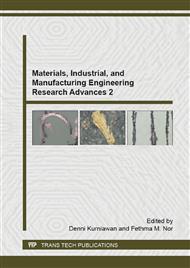p.387
p.395
p.401
p.406
p.411
p.416
p.421
p.426
p.432
Composite of Poly Lactid Co-Glycolic Acid (PLGA)-Collagen Coated by Chitosan as Candidate of Hollow Fiber Small Diameter Vascular Graft
Abstract:
Heart failure is a serious major health problem with high number of mortality per year. Bypass is one of the solutions that has often been taken. Nowadays, synthetic materials have been fabricated from polymers to solve the disadvantages which are provided by autograft, allograft and xenograft. The aim of this research is to make a synthetic vascular graft with great physical strength, high biocompatibility, and good affordability. The method of this research was mixing PLGA and collagen by magnetic stirrer. This composite were shaped by spinneret with water as coagulant. Then it was coated by chitosan with 3 variations of weight (1 %wt, 2 %wt, and 3 %wt) to increase hemo and cytocompatibility, proliferation, and cell attachment in order for the vascular graft candidates to be more biocompatible. Mechanical strength for each variation was 5,306 MPa (chitosan 1 %wt), 3,433 MPa (chitosan 2 %wt) and 3,745 MPa (chitosan 3 %wt). All the tensile values were higher than human vascular tensile strength. Toxicity test showed that the living cells in all variations were more than 60% in number, thus the vascular graft is not toxic.Hemolytic assay showed that the lowest coagulation was provided by sample with 3 %wt chitosan.
Info:
Periodical:
Pages:
411-415
Citation:
Online since:
October 2015
Keywords:
Price:
Сopyright:
© 2015 Trans Tech Publications Ltd. All Rights Reserved
Share:
Citation:


